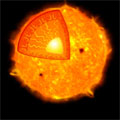An overview of the Chandra mission and goals, Chandra's namesake, top 10 facts.
Classroom activities, printable materials, interactive games & more.
Overview of X-ray Astronomy and X-ray sources: black holes to galaxy clusters.
All Chandra images released to the public listed by date & by category
Current Chandra press releases, status reports, interviews & biographies.
A collection of multimedia, illustrations & animations, a glossary, FAQ & more.
A collection of illustrations, animations and video.
Chandra discoveries in an audio/video format.
Reading Stellar Neon Signs
July 27, 2005 ::
Our understanding of the average life of an average star comes primarily
from studying one star: our Sun. But, despite being our closest and most
studied star, astronomers are still trying to determine some of the Sun's
key properties.
Scientists fold the most accurate measurements they have of the Sun's
composition, size and brightness into what is called the "solar model".
When combined with the best available physics, scientists use the solar
model to make precise predictions of the interior structure and the
dynamics of the Sun.
Astronomers have known the basic composition of the Sun for many years, but
are still working on the fine details of the solar mixture. These details
turn out to be important for understanding the Sun. Using paint as an
analogy, think of trying to match a new can of paint to a color on a wall.
You take a gallon of white paint to the hardware store, show them a sample
of the color you want, and ask them to mix it for you. If just the right
amount of other colors is added to the white base, you can come up with the
perfect match.
Pretend that the Sun is that gallon of paint. Astronomers know that the
Sun's primary ingredients are hydrogen and helium, the two lightest
elements in nature. In our analogy, those elements are the white base
coat already in the paint can.
Just as the person in the hardware store has to add just the right
amount of just the right selection of colors, so too must scientists
find the precise elements and quantities to fold into the helium and
hydrogen base. Scientists, in short, have had some problems getting the
right colors and quantities to match the paint on the wall.
Recently, astronomers came up with new and improved methods, using
complicated mathematical models in three-dimensions, for measuring
abundances (the amount of each paint color in our analogy) on the Sun.
They found the Sun had significantly reduced quantities of carbon,
nitrogen, oxygen, and neon, which fortunately agreed with the abundances
measured in the gas within a few hundred light years of the Sun. Since the
Sun is presumed to have been born from just this material, the same amount
of carbon and oxygen should be found in both. Thus one long-standing
problem was solved.
 |
| The Sun is too close and bright for Chandra to observe with its extremely sensitive detectors. This X-ray image of the Sun is from the Yohkoh satellite. |
However, a bigger problem remained. The new solar model with smaller
amounts of these elements made predictions for well known properties of the
Sun that no longer agreed with observations. Astronomers furiously studied
the observations and the model to try to reconcile the two. One possible
solution lay in the element
neon, which plays an important role in
regulating the rate of energy flow in the Sun. Theorists found
that if, by some chance, the amount of neon in the Sun were to be about 3
times higher than the best measurements to date, the solar model would fall
back into agreement with all known data.
Neon cannot be seen in optical light from the Sun, but when it is heated to
extremely high temperatures it emits X-rays. A pair of scientists used data
from the Chandra X-ray telescope to analyze 21 nearby stars, similar to the
Sun, searching for neon. The amount of neon in the nearby stars was found
to be 2.7 times higher than previously thought. This result implied that
neon is overabundant in the Sun by the same amount, and thanks to Chandra,
a problem that could have taken years to untangle may be resolved.








